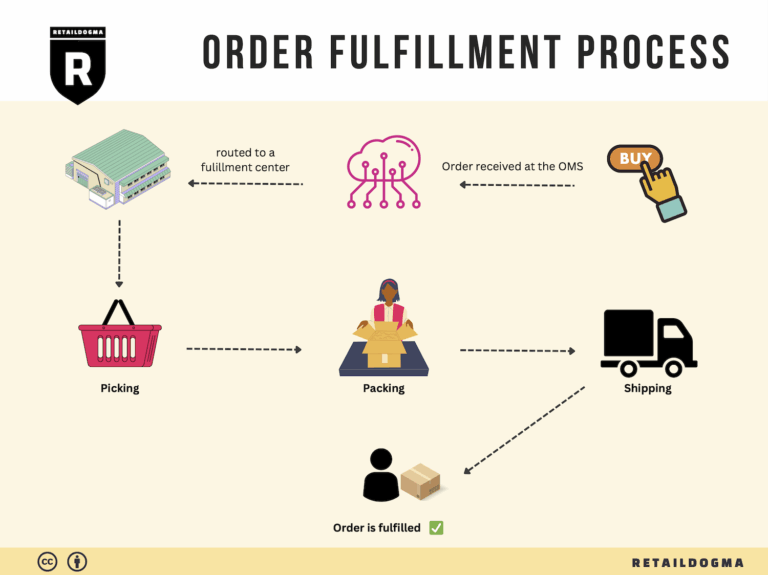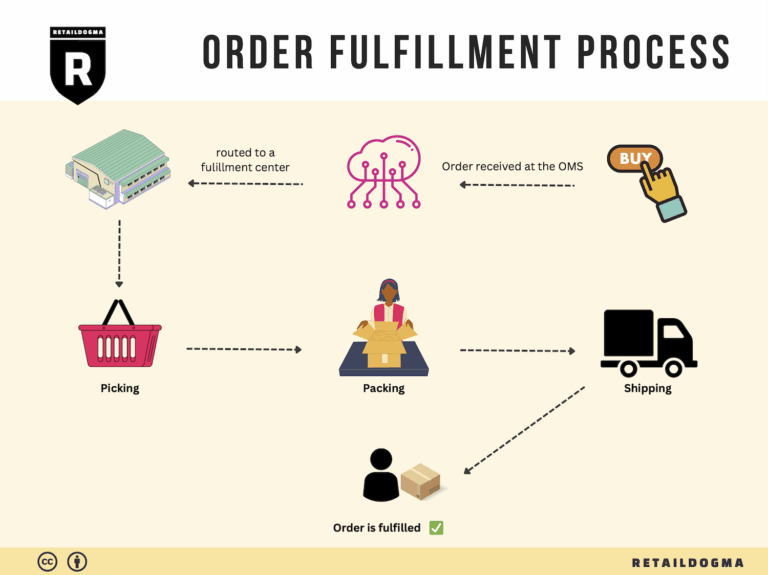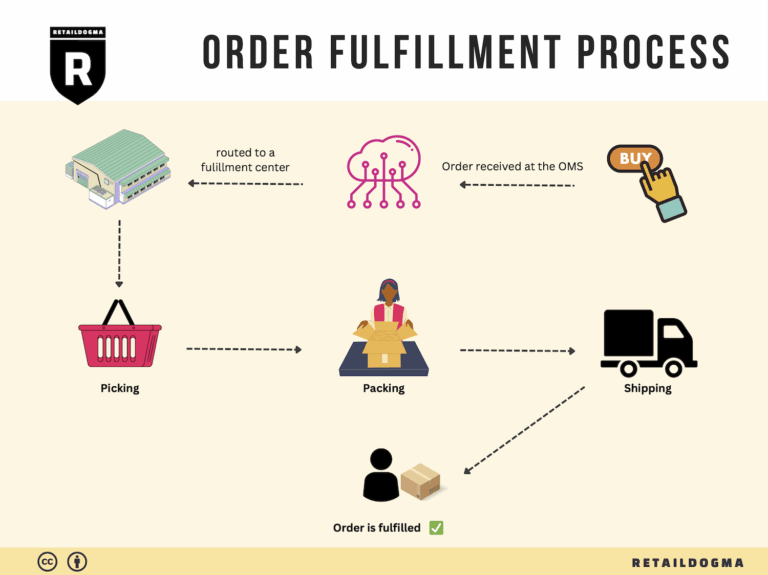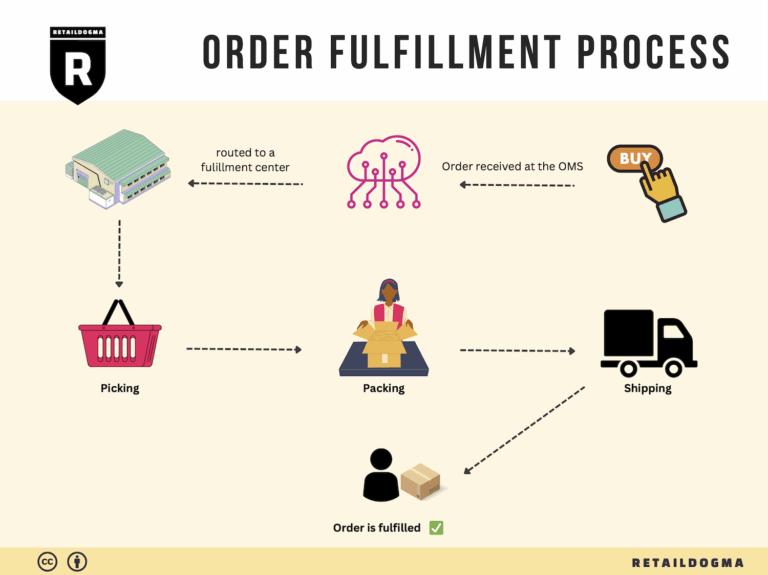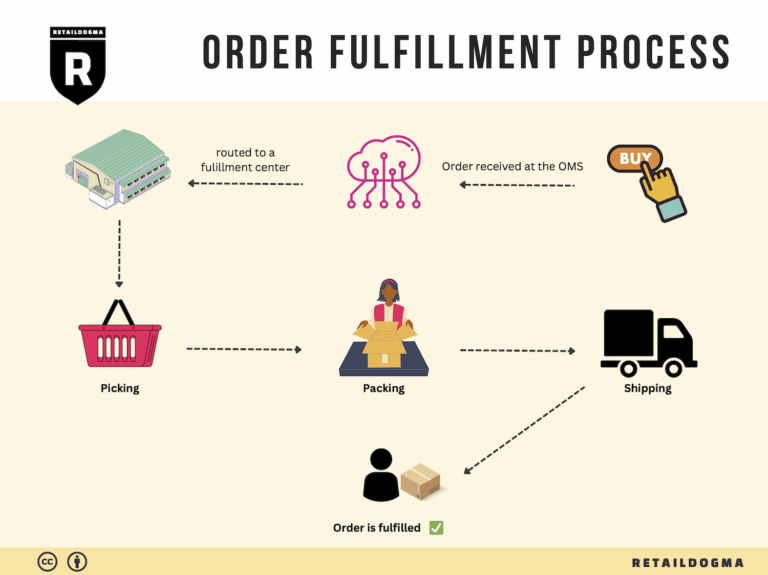What Is A Fulfillment Center? A Complete Guide (2025)
What is E-commerce Fulfillment? An Introduction for Growing Businesses
Understanding E-commerce Fulfillment: A Key to Business Growth
As an e-commerce business owner, you may often find yourself drowning in the endless cycle of packing and shipping orders. This overwhelming task can divert your focus from growing your business and nurturing customer relationships. E-commerce fulfillment is the solution to this challenge, streamlining the process of getting products to customers efficiently and effectively.
At its core, fulfillment is the comprehensive process that involves storing inventory, picking and packing orders, and shipping them to customers. As your online business expands, mastering the logistics of fulfillment becomes increasingly critical. Poor fulfillment practices can lead to delayed shipments, inventory errors, and ultimately, unhappy customers—factors that can stifle growth and damage your brand reputation.
This guide will explore the various fulfillment models available to growing businesses, including Third-Party Logistics (3PL) and Fulfillment by Amazon (FBA). Each model has its unique advantages and can cater to different business needs depending on your scale, product type, and target market. We will delve into the core services offered by fulfillment partners, such as inventory management, order processing, and returns handling, to help you understand what to expect from your logistics provider.
Choosing the right fulfillment partner is crucial for the success of your e-commerce operations. This guide will provide practical tips on how to evaluate potential partners, including assessing their technology, customer service, and scalability. We will also touch upon pricing structures, helping you navigate the costs associated with various fulfillment options and how they can impact your bottom line.
Ultimately, the goal of this guide is to empower you with the knowledge needed to make informed decisions about your logistics strategy. By understanding the nuances of e-commerce fulfillment, you can optimize your operations, enhance customer satisfaction, and position your business for sustainable growth in an increasingly competitive landscape. Whether you’re just starting out or looking to scale, effective fulfillment can be your competitive advantage.
What You’ll Learn In This Guide
- What is E-commerce Fulfillment? An Introduction for Growing Businesses
- The Order Fulfillment Process: From ‘Buy’ Button to Customer’s Door
- Comparing Fulfillment Models: In-House vs. 3PL vs. Dropshipping
- A Deep Dive into Amazon FBA: Pros, Cons, and Who It’s For
- Core Services Offered by Fulfillment Centers
- How to Choose a Fulfillment Partner: A 6-Point Checklist
- Understanding Fulfillment Pricing: A Breakdown of Common Fees
- Frequently Asked Questions (FAQs) about Fulfillment
- Conclusion: Is Outsourcing Fulfillment the Right Move for Your Business?
- Important Disclaimer
The Order Fulfillment Process: From ‘Buy’ Button to Customer’s Door
1. Receiving Inventory
The order fulfillment process begins with receiving inventory. This step involves the acceptance of products from suppliers or manufacturers into the warehouse. Upon arrival, goods are inspected for quality and quantity against the purchase orders. This ensures that the correct items have been received and that they are in acceptable condition.
Importance: Proper receiving is crucial as it sets the stage for the entire fulfillment process. Any discrepancies at this stage can lead to inventory shortages or surpluses, which can affect order fulfillment down the line.
Key Term: SKU (Stock Keeping Unit) – Each product is assigned a unique SKU, which helps in tracking and managing inventory levels efficiently.
2. Warehouse Storage
Once inventory is received, the next step is warehouse storage. This involves organizing the products in the warehouse according to a systematic layout, which optimizes space and facilitates easy access. Products are typically categorized by type, size, or frequency of order to streamline future picking processes.
Importance: Efficient storage minimizes the time and effort required to locate items, which is critical for speeding up the order fulfillment process. A well-organized warehouse can significantly reduce the risk of errors during order picking.
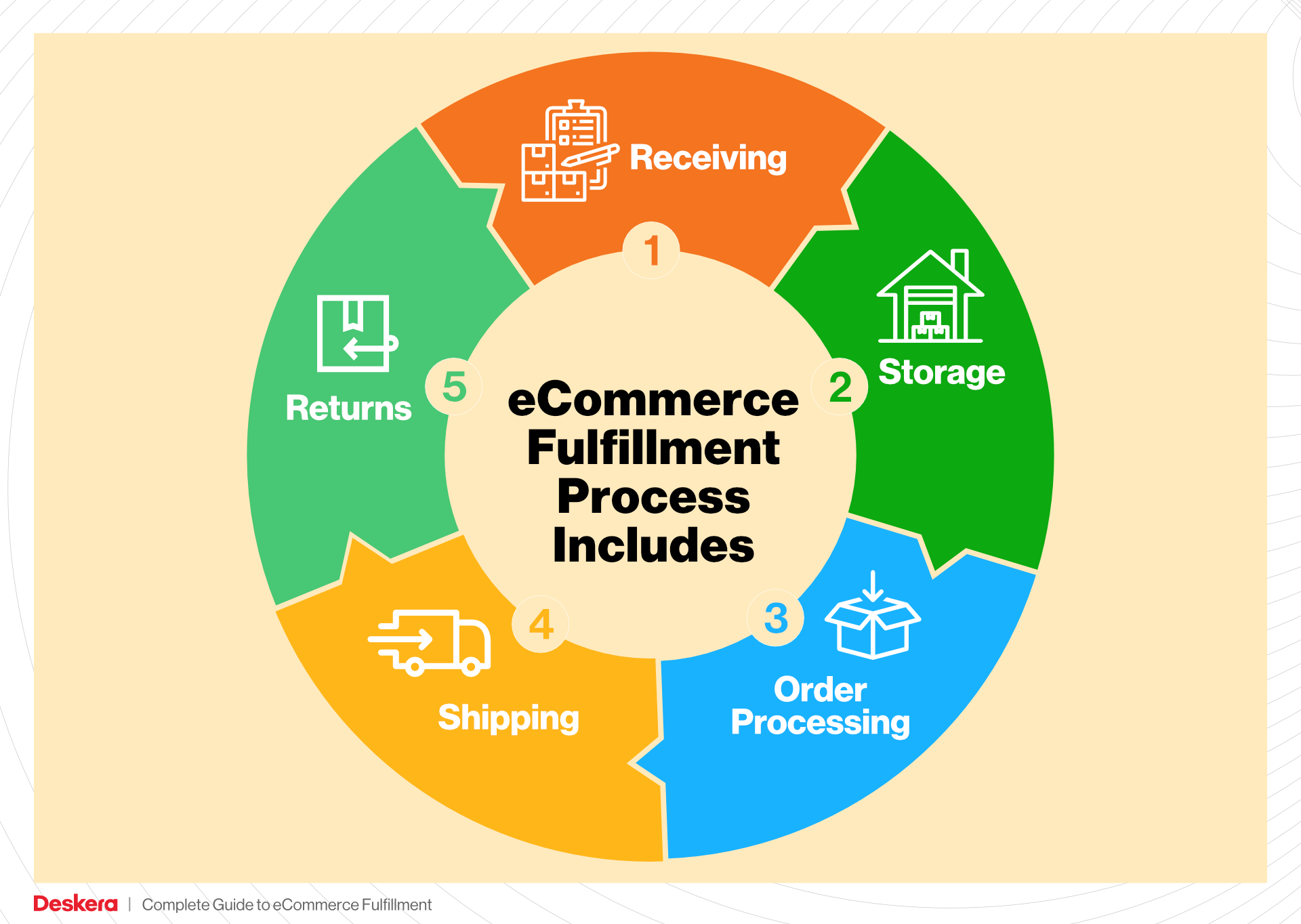
Key Term: FIFO (First In, First Out) – This inventory management method ensures that older stock is sold before newer stock, thereby reducing waste and ensuring product freshness.
3. Order Picking
Order picking is the process of selecting products from the warehouse to fulfill customer orders. When a customer places an order, a pick list is generated, detailing the SKUs and quantities needed. Warehouse staff then use this list to retrieve the items from their designated storage locations.
Importance: This step is vital because the accuracy of order picking directly impacts customer satisfaction. Mistakes in picking can lead to incorrect shipments, resulting in returns and dissatisfied customers.
Key Term: Pick Lists – These documents guide warehouse staff in efficiently gathering the correct items for each order. They often include barcodes or QR codes to streamline the process further.
4. Order Packing
After picking, the next step is order packing. This involves securely packaging the selected items to ensure they arrive at the customer’s location in good condition. During this stage, items are checked against the original order for accuracy, and appropriate packing materials are used to protect the products.
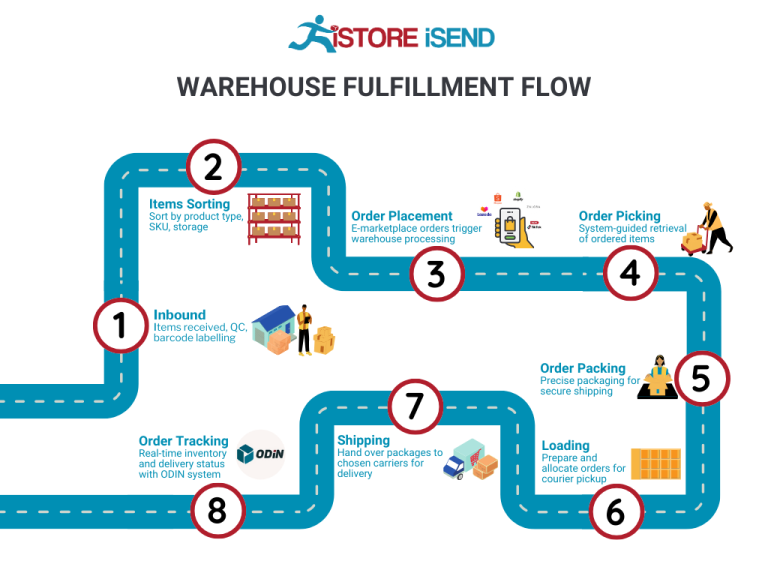
Importance: Proper packing is essential to prevent damage during transit and to enhance the unboxing experience for customers. This not only preserves product integrity but also reflects positively on the brand.
Key Term: Packing Slip – A document included in the package that outlines the items contained within, serving both as a receipt for the customer and a checklist for the fulfillment team.
5. Shipping & Delivery
The final step in the order fulfillment process is shipping and delivery. Once the order is packed, it is labeled and handed over to a carrier for delivery to the customer’s address. This step involves selecting the most efficient shipping method based on factors like cost, speed, and destination.
Importance: Timely and accurate shipping is critical for customer satisfaction. Delays or errors in delivery can lead to negative customer experiences and harm the brand’s reputation.
Key Term: Last Mile Delivery – This term refers to the final step of the delivery process, where the product reaches the customer’s doorstep. Efficient last-mile delivery is key to achieving high customer satisfaction rates.
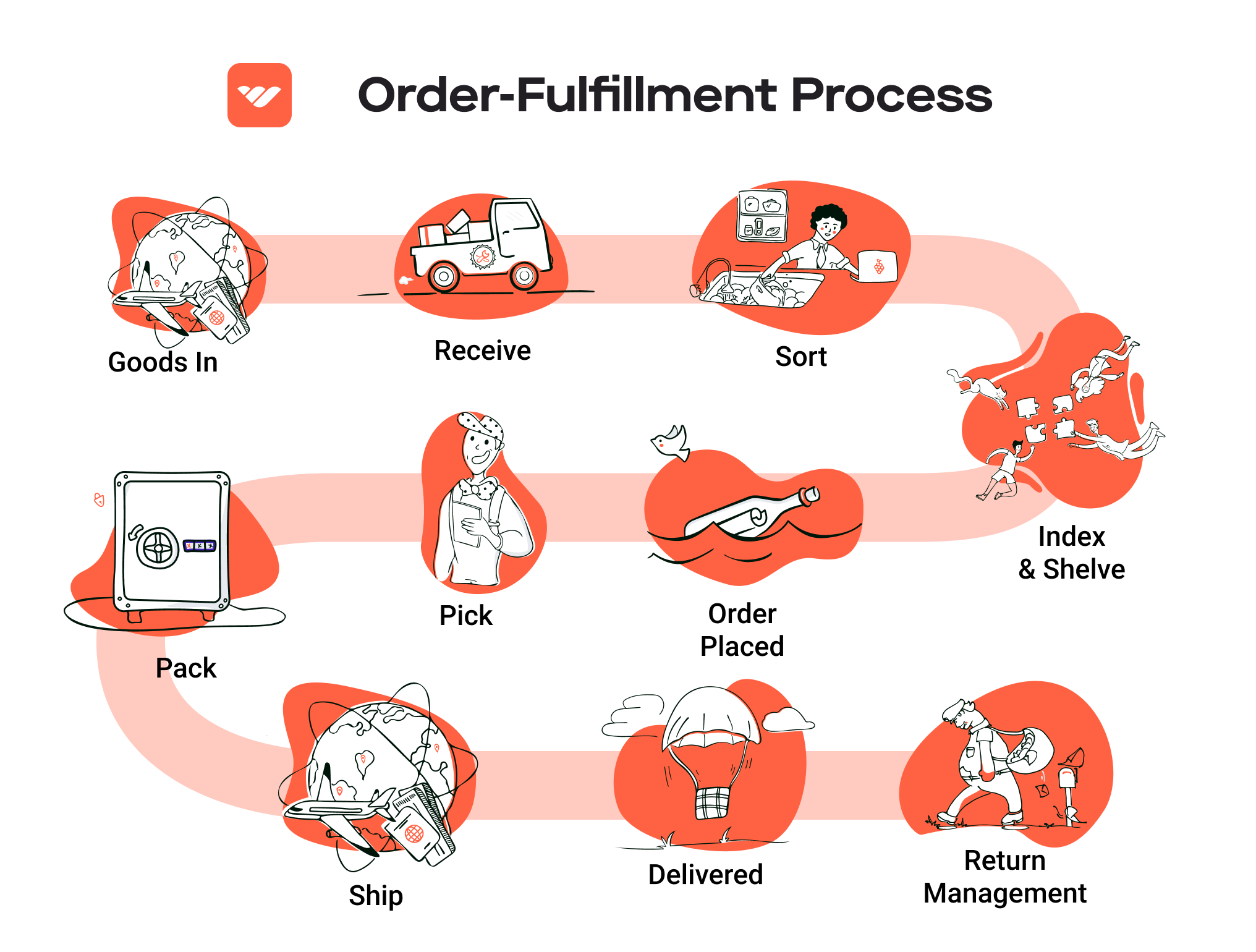
By understanding and optimizing each of these five steps—receiving inventory, warehouse storage, order picking, order packing, and shipping & delivery—e-commerce businesses can enhance their order fulfillment processes, improve customer satisfaction, and ultimately scale their operations effectively.
Comparing Fulfillment Models: In-House vs. 3PL vs. Dropshipping
Fulfillment Model Comparison
| Model | Who Handles Inventory | Best For (Business Stage) | Key Advantage | Key Disadvantage |
|---|---|---|---|---|
| In-House Fulfillment | The business itself | Established businesses | Full control over inventory and process | High overhead costs and complexity |
| Third-Party Logistics (3PL) | Third-party provider | Growing businesses | Scalability and expertise | Less control over the fulfillment process |
| Dropshipping | Supplier | Startups and small businesses | Low upfront investment | Lower profit margins and supplier risk |
In-House Fulfillment
In-house fulfillment refers to managing all aspects of the inventory, warehousing, and shipping processes within the business itself. This model is typically best suited for established businesses that have the financial resources and operational capabilities to handle fulfillment internally. One of the significant advantages of in-house fulfillment is the level of control it offers. Businesses can manage their inventory levels, quality control, and customer experience directly, ensuring that their standards are met consistently. However, this model also comes with significant disadvantages. The overhead costs associated with warehousing, staffing, and maintaining a fulfillment infrastructure can be substantial. Additionally, as demand fluctuates, businesses may find themselves over or under-resourced, leading to inefficiencies in operations.
Third-Party Logistics (3PL)
Third-party logistics (3PL) providers offer outsourced logistics services, including warehousing, inventory management, and shipping. This model is ideal for growing businesses that need to scale their operations without the burden of managing logistics in-house. A key advantage of partnering with a 3PL is access to their expertise and resources, which can lead to improved efficiency and cost savings. 3PLs often leverage economies of scale, meaning they can provide services at a lower cost than an individual business could achieve on its own. However, the primary disadvantage of using a 3PL is the reduced control over the fulfillment process. Businesses must rely on the 3PL’s processes and systems, which can lead to misalignments in service expectations, especially during peak seasons or when issues arise.
Dropshipping
Dropshipping is a fulfillment method where the retailer does not keep goods in stock but instead transfers customer orders and shipment details to a manufacturer or wholesaler, who then ships the goods directly to the customer. This model is particularly advantageous for startups and small businesses looking to minimize upfront investment. The key benefit of dropshipping is the low barrier to entry; businesses can start selling products without the need to invest in inventory or warehousing. However, dropshipping comes with its own set of challenges. Profit margins are often lower compared to other fulfillment methods, and retailers are at the mercy of their suppliers regarding inventory levels, shipping times, and product quality. This reliance can lead to customer dissatisfaction if the supplier fails to meet expectations, making it crucial for businesses to choose reliable partners.
Conclusion
When selecting a fulfillment model, e-commerce business owners must carefully consider their current stage, operational capabilities, and long-term growth strategies. Each model presents unique advantages and disadvantages, and the right choice will depend on factors such as product type, target market, and available resources. By understanding the nuances of in-house fulfillment, 3PL, and dropshipping, businesses can make informed decisions that align with their operational goals and customer expectations.
A Deep Dive into Amazon FBA: Pros, Cons, and Who It’s For
Understanding Fulfillment by Amazon (FBA)
Fulfillment by Amazon (FBA) is a service provided by Amazon that allows sellers to store their products in Amazon’s fulfillment centers. Amazon then takes care of storage, packaging, shipping, and customer service for these products. This service can significantly simplify logistics for e-commerce businesses, allowing them to focus more on sales and less on operational burdens.
How FBA Works
-
Set Up Your FBA Account: To begin using FBA, sellers must create an Amazon seller account and enroll in FBA. This process involves selecting the products to be fulfilled by Amazon and configuring settings related to inventory management.
-
Ship Products to Amazon: Once enrolled, sellers send their products to Amazon’s designated fulfillment centers. Amazon provides guidelines on how to package and label products to ensure they are processed efficiently.
-
Storage and Inventory Management: Amazon stores the products in its fulfillment centers. Sellers can monitor their inventory levels through the Amazon Seller Central dashboard. Amazon manages the inventory, ensuring that products are available for order.
-
Order Processing: When a customer places an order for a product fulfilled by Amazon, the order is processed at the fulfillment center. Amazon picks, packs, and ships the product directly to the customer.
-
Customer Service and Returns: Amazon also handles customer service inquiries and returns for FBA products. This service helps maintain a high level of customer satisfaction and frees sellers from these operational tasks.
Pros of Using FBA
-
Prime Eligibility: One of the most significant advantages of FBA is that products become eligible for Amazon Prime. This can lead to increased visibility and sales, as Prime members are more likely to purchase items that qualify for free two-day shipping.
-
Customer Trust: Amazon has built a strong reputation for reliability and customer service. By using FBA, sellers can leverage this trust, which can positively impact their sales. Customers are more likely to buy from sellers whose products are fulfilled by Amazon due to the assurance of quality service.
-
Multi-Channel Fulfillment: FBA isn’t limited to Amazon sales alone. Sellers can use FBA to fulfill orders from their own websites or other online marketplaces. This multi-channel fulfillment capability allows businesses to streamline logistics across different sales platforms.
-
Scalability: FBA allows businesses to scale operations without the need to invest heavily in logistics infrastructure. As sales grow, sellers can send more inventory to Amazon without worrying about warehousing or shipping capabilities.
-
Time Savings: By outsourcing fulfillment to Amazon, sellers can save significant time and effort. This allows them to focus on marketing, product development, and other growth-oriented activities.
Cons of Using FBA
-
High Fees: While FBA can simplify logistics, it comes with costs that can eat into profit margins. Sellers must pay for storage fees, fulfillment fees, and additional costs for returns or long-term storage. Understanding the fee structure is essential for maintaining profitability.
-
Strict Inventory Rules: Amazon has strict guidelines regarding inventory management, including labeling requirements and storage limits. Sellers must adhere to these rules to avoid penalties, which can be challenging for those unfamiliar with Amazon’s policies.
-
Commingling Risks: FBA allows for commingling of inventory, meaning that products from different sellers can be stored together. This can lead to issues if a seller’s products are mixed with defective or damaged items from other sellers, potentially impacting their reputation and sales.
-
Less Control Over Shipping: When using FBA, sellers relinquish control over the shipping process. This can be a disadvantage for businesses that want to maintain a specific brand experience or offer personalized packaging.
-
Limited Customization: FBA does not allow for much customization in packaging or branding. This can be a drawback for businesses that rely on unique packaging to differentiate their products.
Who is FBA Best For?
FBA is ideal for e-commerce businesses looking to scale quickly without the complexities of managing logistics. It is particularly beneficial for:
-
Small to Medium-Sized Businesses: These businesses may lack the resources to manage their own fulfillment centers and can leverage Amazon’s infrastructure to streamline operations.
-
Sellers with High Sales Volume: Businesses that experience consistent sales can benefit from the efficiencies of FBA, especially those with seasonal spikes in demand.
-
Businesses Seeking Prime Customers: If a seller’s target market includes Amazon Prime members, using FBA is crucial for gaining visibility and increasing sales.
-
Multi-Channel Sellers: Businesses selling on multiple platforms can simplify their logistics by using FBA for all orders, regardless of the sales channel.
In conclusion, while Fulfillment by Amazon offers numerous advantages that can help e-commerce businesses grow and scale, it is essential to weigh these benefits against the potential drawbacks. Understanding the fees, rules, and limitations of FBA will enable sellers to make informed decisions that align with their operational goals and customer expectations.
Core Services Offered by Fulfillment Centers
Inventory Management & Warehousing
Inventory management and warehousing are fundamental services offered by fulfillment centers. This process involves the systematic tracking and storage of products in a dedicated facility. Fulfillment centers utilize advanced inventory management systems that provide real-time data on stock levels, ensuring that businesses can maintain optimal inventory levels without overstocking or running out of popular items.
Benefits:
1. Improved Accuracy: Automated systems reduce human error, ensuring that inventory counts are accurate. This leads to better decision-making regarding restocking and order fulfillment.
2. Space Optimization: Fulfillment centers are designed to maximize storage efficiency. They use techniques such as vertical shelving and dynamic slotting to ensure that products are stored in a way that minimizes space and maximizes accessibility.
3. Scalability: As your e-commerce business grows, a fulfillment center can easily scale its operations to meet increasing demand. This flexibility allows businesses to expand without the burden of managing additional warehousing space.
Pick and Pack Services
Pick and pack services refer to the process of selecting (or “picking”) products from the warehouse and packaging them for shipment to customers. This service is critical for e-commerce businesses, where each order may consist of multiple items that need to be efficiently assembled and shipped.
Benefits:
1. Efficiency: Fulfillment centers employ trained staff and optimized processes to ensure that orders are picked and packed swiftly. This efficiency can significantly reduce order processing times, leading to faster delivery to customers.
2. Quality Control: Many fulfillment centers implement quality control measures during the pick and pack process, ensuring that the correct items are selected and that they are in good condition before shipping. This reduces the likelihood of returns and enhances customer satisfaction.
3. Customization: Fulfillment centers can often accommodate special packaging requests, such as branded boxes or gift wrapping, allowing businesses to enhance their customer experience and brand visibility.
Kitting and Assembly
Kitting and assembly services involve the grouping of multiple products into a single package or kit, which can be particularly beneficial for businesses that sell products that are often bundled together. This service can also include assembling products that require some level of assembly before they can be sold.
Benefits:
1. Enhanced Product Offering: By offering kits or bundled products, businesses can increase average order value and appeal to customers looking for convenience. This can lead to higher sales and improved customer loyalty.
2. Time Savings: Outsourcing kitting and assembly to a fulfillment center frees up internal resources, allowing e-commerce businesses to focus on their core competencies such as marketing and customer service.
3. Inventory Management: Kitting allows businesses to manage inventory more effectively by consolidating multiple SKUs into a single SKU for easier tracking and replenishment.
Returns Management (Reverse Logistics)
Returns management, or reverse logistics, is the process of handling returned merchandise. This service is crucial for e-commerce businesses, where return rates can be significantly higher than in traditional retail settings. Fulfillment centers often provide comprehensive returns management services that streamline the return process for customers and businesses alike.
Benefits:
1. Simplified Process: Fulfillment centers handle the entire returns process, from providing return labels to inspecting returned items and restocking them. This simplification enhances the customer experience, making returns hassle-free.
2. Data Insights: By analyzing return data, fulfillment centers can provide valuable insights into customer behavior and product performance. This information can help businesses identify trends, improve product offerings, and reduce future return rates.
3. Cost Efficiency: Efficient returns management can minimize the costs associated with returns, such as restocking fees and lost inventory. By streamlining the process, fulfillment centers help businesses recover value from returned products more effectively.
In conclusion, partnering with a fulfillment center allows e-commerce businesses to leverage a wide array of essential services, from inventory management to returns processing. By utilizing these services, businesses can enhance their operational efficiency, improve customer satisfaction, and ultimately scale their sales and logistics with ease.
How to Choose a Fulfillment Partner: A 6-Point Checklist
Location & Warehouse Network
Importance:
The geographic location of your fulfillment partner’s warehouses can significantly impact shipping costs and delivery times. A well-distributed network allows for faster delivery to your customers, which is essential for maintaining customer satisfaction and loyalty.
Questions to Ask:
– Where are your warehouses located, and how does this align with my target market?
– What is your average shipping time to major destinations?
– How do you handle shipping during peak seasons or unexpected demand spikes?
Technology & Integrations
Importance:
In today’s e-commerce landscape, technology plays a pivotal role in operational efficiency. A fulfillment partner with advanced technology can provide real-time inventory tracking, automated order processing, and seamless integration with your e-commerce platforms.
Questions to Ask:
– What technology platforms do you use for order management and inventory tracking?
– Can your systems integrate with my current e-commerce platforms (e.g., Shopify, WooCommerce)?
– Do you offer APIs for custom integrations, and how user-friendly are your interfaces?
Specializations (e.g., Cold Storage, Oversized Items)
Importance:
Depending on your product line, you may require a fulfillment partner with specific capabilities, such as cold storage for perishables or handling oversized items. Choosing a partner with the right specializations can prevent logistical challenges and ensure product integrity.
Questions to Ask:
– Do you have the capability to handle specific product requirements, such as temperature-controlled storage?
– What experience do you have with my type of products (e.g., fragile items, hazardous materials)?
– How do you ensure compliance with regulations related to my product category?
Scalability & Capacity
Importance:
As your business grows, your fulfillment partner must be able to scale operations accordingly. A partner with scalable solutions can accommodate increased order volumes without compromising service quality.
Questions to Ask:
– How do you handle fluctuations in order volume, especially during peak seasons?
– What is your capacity for scaling operations if my sales increase significantly?
– Can you provide examples of how you have successfully scaled for other clients in the past?
Pricing and Contracts
Importance:
Understanding the pricing structure and contract terms is crucial to avoid unexpected costs that can erode your profit margins. Transparent pricing helps you budget accurately and plan for growth.
Questions to Ask:
– What is included in your pricing model (e.g., storage fees, shipping costs, handling fees)?
– Are there any additional costs I should be aware of (e.g., for returns or special handling)?
– What are the contract terms regarding cancellation, changes in service, and pricing adjustments?
Customer Support & Reviews
Importance:
Exceptional customer support is vital for resolving issues quickly and maintaining smooth operations. Additionally, checking reviews from other clients can provide insights into the fulfillment partner’s reliability and service quality.
Questions to Ask:
– What customer support channels do you offer (e.g., phone, email, chat)?
– What is your average response time for support inquiries?
– Can you provide references or testimonials from current clients, particularly those in my industry?
Conclusion
Choosing the right fulfillment partner is a critical step in scaling your e-commerce operations. By carefully evaluating each of the above points and asking the right questions, you can ensure that your chosen partner aligns with your business needs and growth objectives. This thorough approach will help you build a strong foundation for your logistics strategy, ultimately leading to enhanced customer satisfaction and business success.
Understanding Fulfillment Pricing: A Breakdown of Common Fees
Initial Setup Fees
Initial setup fees are often the first expense you encounter when partnering with a fulfillment provider. These fees cover the onboarding process, which typically includes setting up your account, integrating your e-commerce platform with the fulfillment system, and configuring inventory management settings. Depending on the complexity of your requirements, these fees can range from a few hundred to several thousand dollars.
To calculate these fees, providers may consider factors such as the number of SKUs you have, the level of customization needed for your integration, and any additional services you may require, such as training for your team. It’s essential to discuss these details upfront to avoid unexpected costs later.
Receiving Fees
Receiving fees are charged for the process of accepting and inspecting inventory when it arrives at the fulfillment center. This fee generally covers the labor involved in unloading shipments, checking items against purchase orders, and putting them into storage.
Receiving fees can be calculated based on the number of pallets or boxes received, or as a flat fee per shipment. For example, a provider may charge a per-pallet fee that could range from $10 to $50, depending on the complexity of the receiving process and the volume of goods. When evaluating potential providers, ask about their receiving procedures to ensure they align with your operational needs.
Storage Fees (per pallet/bin)
Storage fees are ongoing charges for keeping your inventory in the fulfillment center. These fees can vary widely based on several factors, including the size of your products and the type of storage space you require (e.g., temperature-controlled, standard).
Typically, storage fees are calculated on a per-pallet or per-bin basis, with costs ranging from $5 to $25 per month per pallet. Some providers may also implement tiered pricing, where the rate decreases as you store more pallets. Understanding how your inventory turnover affects storage costs is crucial, as high inventory levels can lead to increased expenses.
Pick & Pack Fees (per item/order)
Pick and pack fees are charged for the process of retrieving items from storage and packaging them for shipment. This fee is a significant component of fulfillment costs, as it directly impacts labor and operational efficiency.
Providers usually calculate pick and pack fees on a per-item or per-order basis. For instance, you might see charges of $1 to $5 per item picked and packed, with potential discounts for larger orders. Additionally, some companies may charge a flat fee per order, which can be beneficial for businesses with a high volume of smaller orders. It’s vital to clarify the pick and pack process with your provider to ensure it meets your operational workflow.
Shipping Fees
Shipping fees are often one of the most variable components of fulfillment pricing. These fees cover the cost of transporting packages from the fulfillment center to the end customer. Factors influencing shipping costs include package dimensions, weight, destination, and the carrier used.
Shipping fees can be calculated in various ways, such as flat rates, weight-based pricing, or distance-based charges. Providers may also offer discounted rates with specific carriers due to volume agreements. Understanding your shipping needs and volume can help you negotiate better rates and determine the most cost-effective shipping strategies.
Tips for Getting an Accurate Quote
When seeking fulfillment services, obtaining an accurate quote is crucial for budgeting and financial planning. Here are some practical tips:
-
Be Specific About Your Needs: Clearly outline your inventory types, order volumes, and any special requirements (like kitting or custom packaging). This information will enable providers to give you a more precise estimate.
-
Ask About Hidden Fees: Inquire about any potential hidden fees that could affect your overall costs, such as account maintenance fees or additional charges for returns.
-
Request a Detailed Breakdown: A detailed breakdown of all fees will help you understand how each component contributes to the total cost. Look for transparency in pricing models.
-
Compare Multiple Providers: Don’t settle for the first quote. Gather multiple quotes from different fulfillment providers to compare services and pricing structures.
-
Negotiate Terms: Many fulfillment centers are open to negotiation, especially for long-term contracts or higher volumes. Don’t hesitate to discuss terms that can benefit your business.
By understanding these common fulfillment pricing models and following these tips, you can make informed decisions that align with your business goals and help streamline your e-commerce operations.
Frequently Asked Questions (FAQs) about Fulfillment
1. What is Aunt Peg Fulfillment?
Aunt Peg Fulfillment refers to a niche in the fulfillment industry, primarily associated with the logistics and distribution of adult-themed products and media. It encompasses services that manage inventory, order processing, and shipping, tailored specifically for businesses operating within the adult entertainment sector.
2. What is the difference between a warehouse and a fulfillment center?
A warehouse is primarily a storage facility for goods, focusing on inventory management without necessarily handling order fulfillment. In contrast, a fulfillment center is designed to process orders, including picking, packing, and shipping products directly to customers. Fulfillment centers often provide additional services such as returns management and customer support, making them integral to e-commerce operations.
3. What is a 3PL (Third-Party Logistics)?
A 3PL, or third-party logistics provider, is a company that offers outsourced logistics services, including transportation, warehousing, and fulfillment. Businesses partner with 3PLs to leverage their expertise, technology, and resources, allowing them to scale operations without the overhead of managing logistics in-house.
4. How much do fulfillment services cost?
The cost of fulfillment services can vary widely based on several factors, including the volume of orders, the type of products, and the specific services required. Typically, costs may include storage fees, picking and packing fees, shipping charges, and additional service fees. It’s essential for businesses to request quotes from multiple fulfillment providers to determine the best fit for their budget and needs.
5. How can Aunt Peg Fulfillment help scale my business?
Aunt Peg Fulfillment can help scale your business by providing specialized logistics services tailored to the adult entertainment industry. This includes efficient inventory management, streamlined order processing, and reliable shipping solutions. By outsourcing these functions, you can focus on growing your brand and customer base, while ensuring that fulfillment operations run smoothly.
6. What types of products can be fulfilled through Aunt Peg Fulfillment?
Aunt Peg Fulfillment specializes in handling a variety of adult-themed products, including adult films, toys, apparel, and accessories. The services are designed to accommodate the unique requirements of these products, ensuring compliance with regulations and industry standards.
7. What technology is typically used in fulfillment centers?
Fulfillment centers often utilize advanced technology such as warehouse management systems (WMS), inventory management software, and automated picking systems. These technologies help streamline operations, improve accuracy, and enhance the speed of order fulfillment, ultimately leading to better customer satisfaction.
8. How do I choose the right fulfillment partner?
When selecting a fulfillment partner, consider factors such as their experience in your industry, the range of services offered, technology capabilities, pricing structure, and customer service. It’s also beneficial to seek testimonials or case studies from businesses similar to yours to gauge the provider’s reliability and effectiveness.
9. What is the typical turnaround time for order fulfillment?
Turnaround times for order fulfillment can vary based on the fulfillment center’s operational efficiency and the complexity of the order. Generally, most fulfillment centers aim to process orders within 24 to 48 hours after receipt. However, factors such as inventory availability and shipping methods can influence delivery times.
10. How do returns work in Aunt Peg Fulfillment?
Returns in Aunt Peg Fulfillment are managed through a defined process that includes receiving returned items, inspecting them for quality, and restocking or disposing of them as necessary. Fulfillment centers typically offer returns management services, helping businesses handle customer returns efficiently and maintain customer satisfaction.
Conclusion: Is Outsourcing Fulfillment the Right Move for Your Business?
Evaluating the Benefits of Outsourcing Fulfillment
As you weigh the decision to outsource your fulfillment operations, it’s crucial to consider the myriad benefits that come with partnering with a specialized fulfillment service. One of the most significant advantages is the time savings. By outsourcing fulfillment, you free up valuable resources, allowing you to focus on core business functions such as product development, marketing, and customer engagement. This shift not only enhances your operational efficiency but also drives growth by enabling you to allocate your efforts where they matter most.
Another compelling reason to consider outsourcing is scalability. A proficient fulfillment partner can adapt to your changing needs, whether you’re experiencing rapid growth during peak seasons or launching new products. This flexibility ensures that you can meet customer demand without the burden of managing logistics in-house, which can often be resource-intensive and complex.
Moreover, leveraging the expertise of a fulfillment service can significantly enhance your overall customer experience. These specialists come equipped with industry knowledge, advanced technology, and streamlined processes that can improve order accuracy and delivery times. Their experience in navigating logistics challenges can lead to better inventory management and cost efficiency, ultimately benefiting your bottom line.
However, the success of outsourcing fulfillment hinges on choosing the right partner. Conduct thorough due diligence to ensure that the service provider aligns with your business goals, understands your market, and can scale alongside you.
Take Action
Now is the time to assess your current fulfillment strategy. Conduct an audit of your shipping processes to identify pain points and inefficiencies. Ask yourself whether a fulfillment partner could streamline your operations and support your growth ambitions. Taking this proactive step could pave the way for enhanced operational performance and increased customer satisfaction, setting your business on a path toward sustainable success.
Important Disclaimer
⚠️ Important Disclaimer
The information in this guide is for educational purposes. Fulfillment services, pricing, and platform features change frequently. Always conduct your own due diligence and consult with providers directly before making business decisions.


